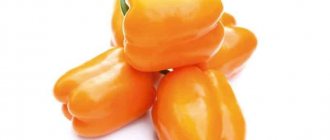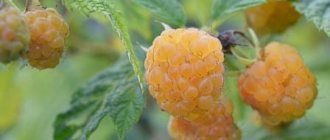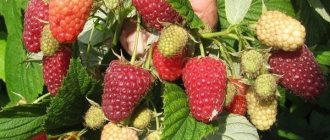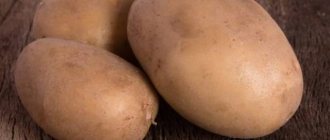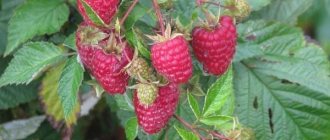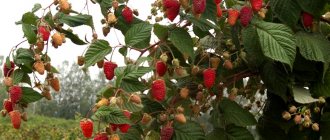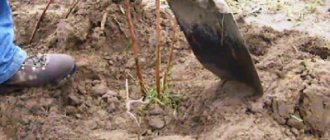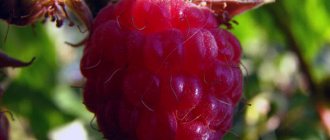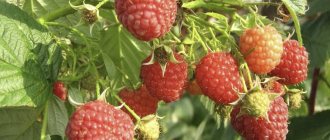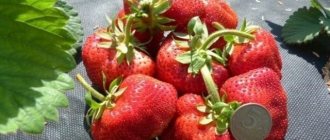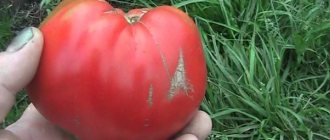History of selection of yellow remontant variety
The Orange Miracle variety is a relatively early variety. It was released in the late 1990s. The famous breeder I.V. Kazakov worked on creating the species.
At the beginning of the 21st century. this variety of remontant raspberries was included in the State Register of the Russian Federation. Based on the description, it is zoned for planting in the middle zone of the country, in particular, for the Moscow region.
Did you know? If you translate the word “raspberry” from Latin, then literally it sounds like “red Ida.” Red
-
This is the most common shade of raspberry varieties.
But Ida is
the name of a Greek nymph. The culture was first discovered on the island. Crete by Pliny the Elder.
Methods for growing raspberries
The crop can be propagated using root shoots. If the crop has survived the winter, its roots are strong and healthy. In such a situation, it is quite acceptable to use them for breeding purposes.
To stimulate the development of root shoots and obtain a sufficient amount of planting material, it is worth removing part of the bush. To do this, in a plant 2-3 years old, it is recommended to select the central shoot and cut it to 10-15 centimeters. This procedure will help you get 20 new bushes.
Description and characteristics of the variety
If we consider the description of the Orange Miracle variety, it is not very different from other popular varieties. This species belongs to crops with medium ripening periods. The first fruits ripen in mid-July. The bushes are of average height, ranging from 1.5–1.7 m. The upright branches have a large number of thorns, which cause discomfort during harvesting.
During active fruiting, when a large number of large berries are formed, the branches may bow to the ground. Each bush consists of 5–7 shoots. The leaves are medium sized, dark green in color. Their surface is wrinkled, and there are sharp teeth along the edges.
Based on the description of the appearance of the berries, the following characteristics are noted:
- Cone-shaped with a round tip.
- The length of the fruit is up to 5 cm, and the weight is between 8–10 g.
- The surface is covered with a velvety coating of a light gray shade.
- During technical ripening, remontant raspberries have an orange or yellow tint.
The pulp of the fruit is juicy and dense. The taste is good. Sweetness and acidity are felt equally. Each berry contains a large number of small drupes, which are not felt when consuming the product.
Did you know? In Europe, the most common varieties are the remontant varieties with yellow or red berries. But raspberries with black fruits were bred in America, and they are the most popular among American farmers.
Description of the variety
Bush
AGRO PREMIUM is an innovative, environmentally friendly plant activator, without chemicals, that protects berries, fruits and vegetables from pests and diseases, increases seed germination, stimulates root formation and plant growth, and significantly increases productivity.
The remontant yellow raspberry Orange Miracle has a rather powerful bush, tall, with spreading branches. Forms 6-7 replacement shoots and the same number of basal shoots.
The stems are covered with a significant number of thorns, which somewhat complicates the harvesting process.
The leaves are medium sized, deep green with visible wrinkles and jagged edges.
Fruit
Orange miracle is characterized by golden-orange colored fruits. Thanks to the non-standard shade of raspberry, its name appeared.
The berries are oblong conical in shape with a slight bluntness at the tip. Their length can reach 4 cm, and their average weight ranges from 4.5 to 5.5 grams. In some cases, specimens over 10 grams are found.
The taste is sweet, with very little acid. The aroma is not strong, subtle, “raspberry”. The color of the berries can vary from golden yellow to deep orange.
The flesh is dense, elastic, the drupes are small, tightly adjacent to each other. The surface of the berries is characterized by a slight velvety texture.
Thanks to its compacted structure, it tolerates transportation and storage well, making it ideal for growing for commercial purposes.
General characteristics
It is distinguished by a generous, stable harvest. The share of the autumn harvest in the total harvest is about 70%.
From 2.5 to 3 kg of berries are harvested from one bush. Usually, the Orange Miracle fully realizes its potential harvest before the first frost.
Raspberry Orange miracle is characterized by high resistance to diseases and pests, but is quite susceptible to severe frosts and excessive heat.
Advantages and disadvantages
- When considering the description of the remontant raspberry variety Orange Miracle, the following advantages are noted:
- large berries with an increased amount of juice in the pulp;
- stable yield indicators;
- ease of care;
- high winter hardiness;
- not affected by most fungal diseases;
- pest resistance;
- versatility of use;
- the berries do not fall off when ripe;
- possibility of long-term transportation.
There are few disadvantages to this popular type. The main ones are the small number of shoots that form from the main trunk, as well as the need for regular tying up of bushes.
Video: Raspberry variety Orange Miracle
Drought resistance, frost resistance
The variety of remontant raspberry Orange Miracle has high drought resistance . If you properly care for the bushes, regulating the amount of fertilizing and watering, the bushes can withstand temperatures up to +35°C. Watering the beds is allowed at intervals of a week, which differs significantly from the demands of other agricultural crops.
Winter hardiness indicators are excellent . Since this variety is ideal for growing in the central part of the country and the Moscow region, it is able to withstand early frosts that reach a temperature of -16°C.
We collect and store raspberries
With proper care, the variety produces a stable harvest of impressive volumes. Berries should be picked only on a dry day 2-3 times a week.
If raspberries are stored, it is not recommended to wash the berries.
Berries can be stored for some time in a cool (15°C) and ventilated room without exposing the fruit to sunlight. The fruits will last no more than a week in the refrigerator.
If the berries are planned to be stored for a short period of time, they can be placed in shallow containers and placed in a cool place
The orange miracle has the ability to ripen on a broken branch placed in water. Such a “bouquet” will remain fresh for 8–10 days.
In addition to jam, which has not only a great taste and aroma, but also a very unusual color, raspberries are frozen for the winter in ordinary household or special fast-freezing chambers, and also dried in dehydrators, after which the berry becomes smaller in volume and sweeter in taste.
Dried raspberries are sweeter, take up less space and last longer
Landing Features
Like most other varieties of remontant raspberries, Orange Miracle is planted in early autumn . You must first take care of choosing planting material, since the quality of the future harvest depends on it.
The gardener must study in advance all the features of the description and requirements of the crop in order to provide it with quality care. Follow the optimal planting scheme so that the bushes feel comfortable.
Video: Features of planting and caring for remontant raspberries
Deadlines
It is impossible to name specific planting dates, since they depend on the type of root system and climatic conditions of the region. In the northern and western regions of the country, planting is carried out in the spring so that the plant acclimatizes to the first frosts. In the southern and central regions, planting material can be planted in the fall . Immediately after planting, the plants are covered to protect them from sudden changes in temperature.
Depending on the type of root system, there are several planting dates:
- in April and early May, bushes with an open root system are planted. It is important to plant them before the sap begins to flow inside the stem;
- a month before the onset of cold weather, plants with a closed root system are planted, i.e. there should be a lump of earth on the roots. This will allow the bushes to adapt to the new location.
Find out more about the features of autumn planting raspberries.
Choosing a suitable location
To ensure that the development of bushes does not stop, it is necessary to carefully approach the choice of planting site. Bushes are placed in well-lit garden areas so that they do not fall into the shade. The amount of harvest and its taste depend on the amount of sunlight. Try to plant in the southern part of the site, as this is where the daylight hours are longest.
The orange miracle is not picky about soil conditions, so it can be planted in any soil. The highest yields are observed after planting in loamy soils.
When choosing soil, you need to take into account some of its features:
- good moisture absorption;
- proper air exchange so that the root system is not affected by diseases.
Important! The acid-base balance of the soil should be no more than 6%. If you ignore this indicator, the berries will be small in size with a bland taste.
Selection and preparation of planting material
When the question arises which seedling is best to use for planting, consider the following recommendations:
- Buy planting material from specialized stores or nurseries. Purchasing at regular markets risks replacing a tasty and original variety with a wild one. Also, some seedlings may be affected by diseases or parasites.
- There must be at least 3 shoots on the trunk of the planting material.
- The maximum length of shoots should be 30 cm. Otherwise, the plant will not take root in its new location.
- Make your purchase in September or October. At this time, the sap in the stems moves minimally, so there is a low chance of damaging the seedlings when digging them up.
Preparing the planting site involves treating it with growth stimulants. The best among them are considered to be “Kornevin” (20 g per 5 liters of water) or “Gumat” (50 g per 5 liters of water). The plant is placed in this volume of solution and left in this position for 3 hours. This will allow it to take root faster after planting. To prevent the root system from becoming rotten, add 200 ml of Ridomil to the growth stimulator solution. This drug will create an invisible protective film on the roots.
Landing algorithm
There are optimal step-by-step planting instructions:
- A week before planting, holes are dug. Their depth should be 40 cm and width 60 cm. A distance of 90–100 cm is maintained between the pits.
- The distance between the rows should be 2 m so that the bushes do not intertwine with each other. This will preserve their appearance and make the process of cleaning the products easier.
- 50 g of superphosphate is poured into the wells.
- A seedling is placed inside, placed vertically and covered tightly with earth. It is impossible for voids to form in the root system.
- Compact the soil and water each bush with 20 liters of warm water.
Important! Nitrogen components should not be used during well preparation. They will dry out the soil, slowing down the growth of bushes.
How to care
Loosening the soil
It is necessary to loosen the soil regularly. This is the only way to prevent the development of diseases and pest damage. It is best to loosen after watering or rain.
At the same time, remember that the root system of the Orange miracle is located close to the surface, so you should not get too carried away during loosening.
Watering
For the Orange Miracle variety, it is important that the soil is always moist. But it will not tolerate standing water. It is necessary to water once a week. If the summer is too dry, watering should be done 2 times a week.
Top dressing
In the spring, the soil is loosened, after which manure is embedded in the soil, which is already well rotted before application. The amount of fertilizer is about 7 liters per square meter.
Double superphosphate in granules is also added here, the amount is 25 g, potassium nitrate is added to it, in the amount of 15 g. After half an hour, the fertilized area should be well watered.
In early June, you should water the raspberries with fresh infusion with manure, nettle, dandelion, and bird droppings.
To prepare such an infusion, you should select a large container, add all the ingredients in equal proportions and fill with water so that the amount of water is twice the amount of prepared raw materials.
The container is tightly closed with a lid and left for a week, after which the contents are mixed and diluted with water in the proportion: 1 part fertilizer to 8 parts water. Watering is done with 2 liters of solution per bush.
After a month, the plant should be fed with a special purchased fertilizer for raspberries, such as Kemir or Amofoska, according to the instructions.
At the beginning of the autumn period, fertilizing is carried out with the same fertilizer, according to the instructions. After the harvest is harvested, raspberries are fertilized with double superphosphate - 30 g and potassium nitrate - 20 g.
A measured amount of dry ingredients is diluted in 5 liters of water; this amount of liquid is enough to water one bush. These fertilizers can be poured dry under each bush, subject to rainy weather.
Mandatory Garter
Due to the fact that the stems of the Orange Miracle raspberry easily bend under the weight of the harvest and can easily break from the wind, they need support. The simplest method is to build a trellis.
Supports made of wood or metal are dug into the soil at an equal distance from each other, and wire is stretched between them in 2-3 rows. During the growth process, the bushes are tied to a wire. This method also makes picking raspberries much easier.
Mulching
Backfilling with mulch is done to retain moisture in the soil and insulate the root system for wintering. If you mulch with fertilizer that contains humus, such an event will promote the active growth of young shoots.
It is especially recommended to mulch during planting, while the organic layer should be added in the spring and autumn. As mulch, you can use a combined option: cover the soil with humus, then with straw.
It is not recommended to use pine needles for mulch, as they can increase the acidity of the soil and will interfere with any measures taken to care for the bushes.
Care
If a farmer decides to start growing remontant Orange Miracle raspberries, he must understand that it is not enough to plant correctly. The quality and quantity of the future harvest depends on care. Bushes need to be watered frequently and abundantly. After irrigating the beds, it is necessary that the soil be moistened to a depth of 20–25 cm. Lack of water negatively affects not only the size of the berries, but also reduces the taste. As a result, the fruits become sour.
There are several optimal types of watering:
- drip;
- sprinkling;
- pouring water into holes dug around the bushes.
You cannot water raspberries at the root. This is fraught with exposure of the root system. This will only speed up the death of the bush. To allow moisture from the soil to evaporate longer, mulch the beds. To do this, cover the trunk part with a mixture of straw and humus.
Read more about how to properly mulch raspberries.
If we consider feeding, then the remontant raspberry Orange Miracle is one of those varieties that need a large amount of nitrogen , so water the garden plot monthly with an infusion of cow manure (5 kg per 10 liters of water). During the period of active flowering, water the plants with a superphosphate solution (50 g per 6 liters of water). A week before the start of fruiting, add a potassium solution (100 g per 10 liters of water).
There is a whole scheme according to which the farmer should fertilize the beds:
- At the beginning of April, the soil is loosened and rotted manure is added. 7 kg of fertilizer is applied per 1 m².
- At the beginning of June, watering is carried out with a solution consisting of humus, nettles and bird droppings. All ingredients are used in equal quantities. For 2 kg of this mixture, use 10 liters of warm water. Leave for 2 hours, then water the bushes. For 1 plant use 3 liters of the drug.
- After 20 days, water each bush with 2 liters of Kemira solution (200 ml per 6 liters of water).
- After harvesting, in mid-October the bushes are watered with a mixture of superphosphate and potassium (100 ml of each substance per 10 liters of water). The entire volume of the drug is used for 1 m².
Since the bushes can become deformed under the weight of the berries, it is necessary to garter the shoots . You can use both the horizontal and vertical trellis method. The height of the support should be 2 m, and the first garter should be at the level of 50–60 cm. After this procedure, air exchange between the bushes improves in the raspberry field, preventing the development of fungal infections and rotting of the root system.
Plants are tied up in the spring, before buds begin to form. If you delay this process, you can damage the buds and reduce yields.
The next stage of care is pruning. It is carried out 2 times per season . The shoots are pruned after harvesting. Only 30 cm is left. The second pruning is carried out in the spring. At this time, remove branches that are frozen or broken by the wind.
Caring for the Orange Miracle
Briefly caring for the Orange miracle can be described as follows: loosening the soil, weeding, fertilizing, watering, pruning and covering for the winter.
Loosening and removing weeds
Loosening and weeding is an important component of caring for every plant. Weeds can “strangle” young shoots or create shade that is completely unnecessary for light-loving raspberries. Thanks to regular loosening, you increase the growth and fertility of the bushes, allowing the plants to breathe. But if the bushes are constantly mulched with straw or sawdust to a depth of 15 centimeters, then there is no need for loosening.
Loose soil without weeds contributes to a larger harvest on the raspberry bush
Trimming
With the arrival of summer, you can visually determine the strongest and weakest branches. The latter must be cut at the root, leaving up to 5 strong shoots. This is done so that the plant does not waste energy on weakly fruiting branches.
When the last harvest has been harvested and stable frosts have set in (mid-November), you need to start pruning the raspberries. Remontant varieties have a one-year fruiting cycle. If you leave older shoots, they will produce a harvest, but in much less quantity and of worse quality than new ones. All bushes are cut at the root with sharp pruners. Spent branches are usually burned to prevent the occurrence or spread of diseases characteristic of raspberries.
With the arrival of frosty nights, all branches of remontant raspberries are cut off at the root
Watering
Orange miracle is a moisture-loving variety. If there is insufficient moisture, the berries on the bush become smaller and become more sour. It is important to water the bushes often, for example, once every two days, but not abundantly. If plants are flooded with water, gray rot may appear on them or the roots may simply rot - it is important to focus on the weather and air temperature. Raspberries should be watered by sprinkling from above or into grooves dug near the bushes. Watering under the bush exposes the neck of the root, which leads to the drying out of the entire bush and its death .
Sprinkling method
Fertilizer application
At the beginning of spring, fertilizing with mineral fertilizers is carried out in order to accelerate the growth of shoots, as well as strengthen the root system. Wood ash (a glass) or 15 grams of potassium per square meter. Sprinkle spring snow around the bushes.
Nitrogen fertilizers should not be used in summer. They will lead to the growth of green mass, but not the formation of flowers and berry ovaries.
With the appearance of the first flowers, a second feeding is carried out, 500 grams of mullein per bucket of water, which is allowed to brew for two days. The prepared solution is enough to feed five bushes. Water the bushes slowly and carefully so that the root collar is not exposed.
Preparation of organic fertilizer for raspberries
Herbal infusion will always be relevant as a top dressing and instead of watering. The grass is compacted tightly into a bucket, leaving 15 centimeters from the edge, and the rest of the space is topped up with water, leaving for several days. Water the plants once a week.
The fresh herbal infusion should sit for several days.
Shelter for the winter
The best shelter for remontant raspberries is snow. It protects its stems from freezing. If the branches of ordinary raspberries are bent to the ground and fixed, then with remontant ones everything is much simpler. In winter, snow abundantly covers the bushes cut off from the ground, and the Orange Miracle does not need any other shelter. In regions with little snowy winters, bushes should be covered with straw or sawdust.
Harvesting and storage
The fruiting characteristics of the variety are such that the maximum harvest is harvested in the fall. Since ripe berries stay on the branches for a long time, you don’t have to rush to pick them. The summer resident has at least 2-3 weeks to clean up. It is better to pick berries with the stem to increase shelf life.
We recommend reading how to freeze raspberries for the winter.
Place the harvested crops in plastic baskets. It is folded carefully, in no more than 2 layers. This way the berries will not choke. The maximum weight of 1 basket should be 3 kg. If you place the products in the refrigerator, their shelf life will be 7–10 days. It can also be used to create dried fruits or desserts (to do this, it is mixed with sugar).
The main pros and cons of the variety
This type of raspberry has many advantages:
- High yield. During the summer, up to 3 kilograms of fruit can be obtained from 1 plant.
- Excellent transportability. Even during long-term storage, the density and juiciness of the fruit is maintained. They can be stored at room temperature for 4-5 days. Under ideal conditions, this period increases to 2-3 weeks.
- No berry drop. Even when reaching full maturity, the fruits remain on the bushes.
- Frost resistance. In shelter, the plant can withstand temperatures down to -25 degrees.
- Long-term fruiting. When agrotechnical measures are carried out, raspberries produce a harvest within 15 years.
- Hypoallergenic properties. Allergies are usually caused by red fruits. The Orange Miracle variety does not cause negative reactions.
However, the variety also has several disadvantages:
- Sharp thorns. They are often found even on annual branches.
- The need for tying. Otherwise, the berries may be damaged by thorns.
- Risk of gray rot.
- Poor tolerance to drought.
Preparing for winter
There are several ways to help prepare Orange Miracle raspberries for winter. The most common preparation is to mulch the garden area with pine branches and humus. The procedure is carried out at the end of October. The second option is to bend the shoots to the soil. During these actions, you need to tie the bent shoots together.
The third way to protect plants from frost is to cover them with film or leaves. In regions with snowy winters, shelter can be abandoned. Snowdrifts create a greenhouse effect over the soil, which protects against hypothermia.
Characteristics and varietal characteristics
Before planting a plant, you should familiarize yourself with its key characteristics and varietal characteristics.
Appearance and size of the bush
The plant is characterized by fairly strong and tall bushes that have spreading branches. On each crop, 6-7 replacement shoots and the same number of basal shoots are formed. Many thorns appear on the stems, making harvesting difficult. The culture is characterized by medium leaves of a bright green hue.
Flowering, pollination
The culture is considered remontant, therefore it is characterized by repeated flowering. To increase the yield on the site, it is worth planting several raspberry bushes. This improves pollination.
Ripening time and yield
The first fruits ripen at the end of July. However, the maximum amount of harvest can be harvested at the end of August. At the same time, raspberries continue to bear fruit until frost sets in.
From 1 bush you can get 2.5-3 kilograms of fruit.
Taste qualities and scope of application of berries
This raspberry variety is characterized by large berries weighing 6 grams. They have dense flesh and a cone-shaped shape. The fruits of this variety are characterized by a rich orange color.
Raspberries have excellent taste, which is why they are consumed fresh. The berries are also used to make jams, compotes, desserts and many other dishes.
Immunity to diseases and pests
Remontant raspberry varieties are resistant to various diseases. But if the rules of care are violated and there is no timely prevention, there is a risk of various problems arising.
Bushy dwarfism
This disease is characterized by the formation of yellow areas on branches and leaves. On the affected bushes, berries with a small number of drupes are formed.
Chlorosis
This disease is characterized by yellowing and death of shoots, leaves and other plant fragments. In this case, the fruits are deformed and the process of their ripening stops.
See also
Description of the Zhuravlik raspberry variety, planting and care rules
Read
Gray rot
An unpleasant coating indicates the appearance of gray rot. Damaged fruits must be collected and disposed of.
Aphid
These pests are localized on the underside of leaves or at the ends of shoots. As a result, raspberries stop developing.
To cope with parasites, Karbofos or Confidor are used during bud break.
Raspberry beetle
These pests attack the buds and lead to a significant reduction in yield. To cope with the problem, before flowering the bushes are treated with a solution of Karbofos.
Raspberry weevil
These dark bugs consume green leaves and fruit ovaries. To cope with them, in the spring the bushes and soil should be sprinkled with Karbofos solution. Among the traditional methods, infusions of garlic or mustard help well.
Raspberry stem fly
The threat to plants is posed by larvae that gnaw holes in the stems. During the period of bud formation, it is worth treating the bushes with Karbofos. You can also use Confidor or Decis.
Frost and drought resistance
With proper care, this raspberry variety is characterized by excellent resistance to frost. In regions with harsh winters, bushes need to be covered.
Reproduction methods
There is only one way to propagate remontant raspberries, Orange Miracle. It consists in using shoots of the root system . If the bush did not die after severe winter frosts, then its roots are suitable for propagation.
To get more shoots, it is recommended to remove part of the plant. The central shoot, which is 2 years old, is cut off. Pruning is carried out at 10–20 cm. After such preparation, up to 20 shoots will form on the raspberry.
Advantages
Gardeners include the main positive qualities of the Orange Miracle raspberry variety:
- high productivity;
- the ability of ripe fruits to withstand transportation well over long distances without losing their taste and presentation;
- good shelf life at room temperature and in the refrigerator;
- high resistance to frost;
- this variety can be grown in one place for at least 15 years;
- hypoallergenicity of collected berries;
- high tasting score – 4 points;
- The main unique property of this variety is that plucked branches with unripe berries can ripen indoors if they are placed in a container with water. At the same time, the aroma of raspberries will remain in the room for a long time;
- the harvested crop has a universal purpose.
Diseases and pests
There are several universal drugs that are used to prevent diseases and parasites. To prevent the development of fungal infections, the bushes are treated with Bordeaux mixture (10 g per 10 liters of water). Nitrafen (20 g per 5 liters of water) is used against bacterial diseases. Prevention against pests consists of regularly loosening the soil, eliminating weeds and spraying with manganese solution (1 tbsp per 10 liters of water). The spraying interval is 2 weeks.
Important! If you notice that signs of diseases or parasites have appeared on the bushes, immediately cut off the affected shoots and leaves. After this, they are burned away from the garden so that the spores do not spread throughout the entire area.
If we consider methods of combating common diseases and pests, we should highlight the following:
- Against white spotting , use “Hom” (20 g per 5 liters of water). Treatment is carried out a week before flowering and 14 days after harvesting.
- Treatment of anthracnose involves the use of copper oxychloride (50 g per 10 liters of water) or Topaz (2 ampoules per 3 liters of water). The optimal spraying period is early June.
- against rust (100 g per 10 liters of water). The bushes are treated a week after flowering.
- Spraying with Confidor (20 g per 5 liters of water) or Iskra (100 g per 6 liters of water) helps get rid of the raspberry beetle The bushes are treated a week before the formation of buds.
- Raspberry aphids eliminated during the period of flowering and bud formation. To do this, use a solution of “Aktara” (2 ampoules per 5 liters of water) or “Confidor” (50 g per 5 liters of water).
Growing the Orange Miracle variety is simple and does not require large financial or time expenditures from the farmer. It is enough to follow all the rules for planting and care to grow high-quality products. Be sure to monitor the condition of the bushes. Only they will indicate which elements are not enough for them.
Pruning remontant raspberries
Proper pruning of remontant raspberries is very important for good fruiting. According to the growing technology, plants are mowed in the fall. After collecting the last berries, you need to trim the plants, leaving stumps of about 3 cm. The harvest is produced by annual young shoots that will grow next spring. By the way, this is much more convenient than doing selective pruning, like traditional raspberries. It is advisable to burn the cut stems to get rid of possible pests and pathogens. You can read about signs of disease or pest damage in the article “Diseases and Pests of Raspberries.” Next spring, young strong shoots will appear on the plant, on which the harvest will be formed. With this pruning, raspberries winter well. In case of a snowless winter, it is better to mulch the plants and remove the mulch in the spring.
If you want to get 2 harvests - a summer one and a second autumn one, in the fall damaged or dried stems are removed from the plants.
Very detailed and clear information about both cutting methods - watch the video
The process of planting raspberries of the Orange Miracle variety
- In the planting hole, water the soil and wait until the water is absorbed.
- Place the seedling on a mound of earth formed at the bottom of the hole, straighten the roots so that they point down.
- In small portions, carefully add soil and at the same time compact it with your hands. Make sure that in the filled hole the root collar is flush with the top edge. In light sandy soil, the root collar is buried 3-4 centimeters.
- Around the planted plant at a distance of 25-30 centimeters, form a ring groove to a depth of about 10 centimeters and water the bush generously.
- After half an hour, the soil needs to be mulched with sawdust, dry peat, humus, mown grass, and chopped straw.
The thickness of the mulch layer should be 5 centimeters.
Maintenance requirement
This raspberry variety is not picky about soil, but in order to get good yields of tasty, juicy and aromatic berries, you should not deprive the plant of attention.
The plant does not require anything special in care. It is important to clear the ground of weeds in a timely manner and to carry out loosening in such a way as not to touch the roots, which are located close to the surface of the earth.
It is also necessary to water the bushes regularly, as drought negatively affects the size of the fruit and the yield. But it should be remembered that excess moisture can cause root rot and fungal diseases. Therefore, you should water frequently, especially during periods of drought, but in moderation.
Fruitful, large, sweet
Remontant raspberry Orange miracle - planting and care:
| fb.ru » src=»https://qlumba.com/wp-content/uploads/2019/06/fmg5cf8e0b7735548.jpg» alt=»table_pic_» w /> | Choosing a place and landing Stages:
|
| agronomu.com » src=»https://qlumba.com/wp-content/uploads/2019/06/fmg5cf8e0b819ab50.jpg» alt=»table_pic_» w /> | Watering Stages:
|
| proogorodik.ru » src=»https://qlumba.com/wp-content/uploads/2019/06/fmg5cf8e0ba08acc8.jpg» alt=»table_pic_» w /> | Top dressing Stages:
|
| profogorod.ru » src=»https://qlumba.com/wp-content/uploads/2019/06/fmg5cf8e0bb274769.jpg» alt=»table_pic_» w /> | Trimming Stages:
|
| stylishgarden.ru » src=»https://qlumba.com/wp-content/uploads/2019/06/fmg5cf8e0bc3c4154.jpg» alt=»table_pic_» w /> | Reproduction Stages:
|
| makkgreen.com » src=»https://qlumba.com/wp-content/uploads/2019/06/fmg5cf8e0bd3ac836.jpg» alt=»table_pic_» w /> | Preparing for winter Stages:
|
